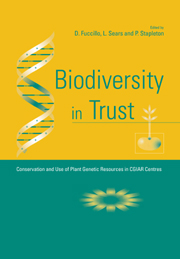Book contents
- Frontmatter
- Contents
- Preface
- Contributors
- Acronyms
- Chapter 1 Cassava
- Chapter 2 The Potato
- Chapter 3 Sweetpotato
- Chapter 4 Other Andean Roots and Tubers
- Chapter 5 Yams
- Chapter 6 Banana and Plantain
- Chapter 7 Cowpea
- Chapter 8 Chickpea
- Chapter 9 Groundnut
- Chapter 10 Lentil
- Chapter 11 Phaseolus Beans
- Chapter 12 Pigeonpea
- Chapter 13 Faba Bean
- Chapter 14 Soyabean
- Chapter 15 Barley
- Chapter 16 Maize, Tripsacum and Teosinte
- Chapter 17 Pearl Millet
- Chapter 18 Small Millets
- Chapter 19 Rice
- Chapter 20 Sorghum
- Chapter 21 Wheat
- Chapter 22 Forages
- Index
Chapter 20 - Sorghum
Published online by Cambridge University Press: 22 September 2009
- Frontmatter
- Contents
- Preface
- Contributors
- Acronyms
- Chapter 1 Cassava
- Chapter 2 The Potato
- Chapter 3 Sweetpotato
- Chapter 4 Other Andean Roots and Tubers
- Chapter 5 Yams
- Chapter 6 Banana and Plantain
- Chapter 7 Cowpea
- Chapter 8 Chickpea
- Chapter 9 Groundnut
- Chapter 10 Lentil
- Chapter 11 Phaseolus Beans
- Chapter 12 Pigeonpea
- Chapter 13 Faba Bean
- Chapter 14 Soyabean
- Chapter 15 Barley
- Chapter 16 Maize, Tripsacum and Teosinte
- Chapter 17 Pearl Millet
- Chapter 18 Small Millets
- Chapter 19 Rice
- Chapter 20 Sorghum
- Chapter 21 Wheat
- Chapter 22 Forages
- Index
Summary
Cultivated sorghum, Sorghum bicolor (L.) Moench, is the fifth most important cereal in the world after rice, wheat, maize and barley. The countries with the greatest areas of sorghum production are India (12.9 million ha), Sudan (5.7 million ha), Nigeria and the USA (4.0 million ha each) and Niger (2.35 million ha). Other major producers include Mexico, Argentina, Colombia and Venezuela in the Americas; Burkina Faso, Ethiopia, Mali, Tanzania, Chad, Cameroon, Somalia and Mozambique in Africa; China, Pakistan and Yemen in Asia. In terms of production, the major sorghum-growing countries of the world are the USA (17.5 million t), India (12.4 million t), China (5.1 million t), Mexico (4.4 million t), Nigeria (4.0 million t) and Sudan (3.3 million t). In many other countries, production is much lower but sorghum is a significant part of the agricultural production and a very important food crop for millions of poor farmers. This is particularly true for rain-fed areas of Asia and Africa. In many areas, the stalks and foliage (used as fodder, fuel, thatching and fencing material) are valued as much as the grain.
BOTANY AND DISTRIBUTION
Sorghum bicolor (L.) Moench (2n=20) is synonomous with Holcus bicolor L., Andropogon sorghum (L.) Brot. and Sorghum vulgare Pers. Sorghum has been called great millet, guinea corn, milo, sorgo (English); sorgho (French); sorgo (Spanish, Portuguese); jowar, cholam, jonna (India); kaoliang (China) and durra (Sudan).
Sorghum bicolor is considered an extremely variable crop-weed complex. It comprises wild, weedy and cultivated annual forms which are fully interfertile.
- Type
- Chapter
- Information
- Biodiversity in TrustConservation and Use of Plant Genetic Resources in CGIAR Centres, pp. 292 - 308Publisher: Cambridge University PressPrint publication year: 1997
- 5
- Cited by

